Philip Liebson
Chicago, Illinois, United States
 |
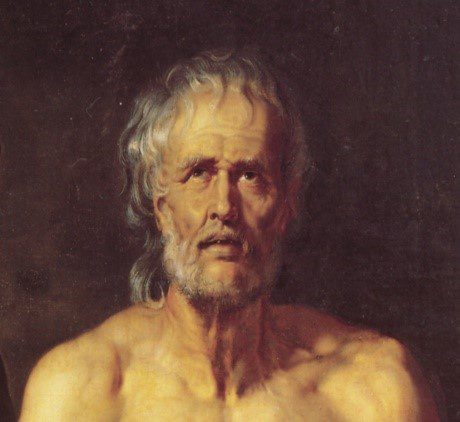 |
We are defining symbolism as the application of physical events and previously collected data about the physical world to explain and illustrate ideas of a moral or spiritual nature. When scientific materials are studied, they would not be evaluated for the purpose of gaining certain generalizations that would explain physical phenomena, but as a means to studying moral implications.
In medieval times, for example, it was not the physical world that was of greatest interest, but man and his relation to the universe. With Hildegard of Bingen (1098-1179), we get a clear example of the approach to such a study. Her work covered such topics as nature and man, the moral world and the material universe, the spheres, winds, and humors, birth and death, the soil, resurrection of the dead and the nature of God. These topics were interwoven and interdependent. To her, there was no distinction between physical events, moral truths, and spiritual experiences. She relied on the idea of microcosm and macrocosm and certain teleological points of view that were akin to those of Plato. Thus, there was a strong Greek influence on the works of this thinker of the middle ages. It is perhaps with her that we reach the epitome of science applied to morality. We will now attempt to trace the steps leading to this extraordinary condition in which mysticism, spiritualism and science became enmeshed.
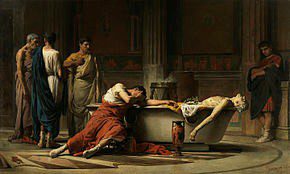 |
| Manuel Domínguez Sánchez, The suicide of Seneca (1871), Museo del Prado |
With the Romans, we already find a philosophical system wherein there is a rigid conception of the interrelation of the different parts of the world, providing thereby little stimulus for the acquisition of new knowledge or for anything in the way of research. In place of knowledge accumulating progressively on a basis of wide and far-reaching theory, we get either a type of exact but intellectually motiveless observation or a rejection of all knowledge of no practical importance. It is perhaps because of the stoic character of Roman philosophy that this tradition did not continue the scientific work of the Greeks. Thus Cato (214 BCE-149 BCE), prepared an encyclopedia for his son focusing on how Roman literature was better than that of Greece without discussing science. In another work we only find miscellaneous contents devoted to rural economy and magical formulae, medical prescriptions and other more strange scientific material.
The Romans were interested in making nature work for people’s benefit. This tradition continued more or less into the medieval period, where nature was studied for explaining the moral purpose of life. The Islamists showed a combination of the Roman and medieval tradition, studying nature for giving them powers, with the spiritual closely related to the physical. That is why Europeans began to flock to the Arabic centers, then bringing their alchemy and magic to the West.
 |
| Plato, Seneca and Aristotle in a medieval manuscript |
This had also been true of Greek philosophers before him, notably Plato. Seneca felt that it was through a general description of the universe that one found knowledge of man’s destiny and through that to a consideration of man’s duty. He believed that moral significance should be attached to all studies and discussion. Whether seeking into the secrets of nature or the nature of divinity, Seneca believed that the soul must be delivered from its errors and from time to time reassured. Throughout his writings he is concerned with teleology,describing things in terms of their apparent purpose, directive principle, or goal, and with morality. He remarks, for instance, that the sun was created so that man could become conscious of his shape. Mirrors were discovered so that man might know himself. This viewpoint appealed to the philosophers of the medieval period and was quite acceptable to the medieval church.
Nevertheless, it is with Seneca that we have one of the few statements of the period of a belief in the progress of knowledge and echo of the Greek thought of the fourth and fifth centuries BC. His Natural Questions is a study on questions of physics and meteorology. It is one of the few Roman works that deals with scientific matters. It is not a systematic work, but a collection of facts of nature from various writers, Greek and Roman, many of which are curiosities. He deals with astronomy, meteorology and geography and considers natural phenomena in relation to his conception of the world scheme as a whole. Moral remarks are scattered through the work; and indeed the design of the whole appears to be to find a foundation for ethics in the knowledge of nature. He remarks on how many heavenly bodies revolve unseen by the human eye and how many discoveries are reserved for the ages to come for the world contains matter for investigation for all generations. However, all physical things are part of the nature of the deity and it is only though the spirit that wisdom can be obtained. We see in this work very little knowledge of natural phenomena, but a concern about the philosophical relations of the science with morality. This is a typical compendium of the times.
 |
 |
Thus, his thoughts are characteristic of the nature of the Roman world in believing that knowledge of a general nature cannot come alone from observation of phenomena, but must be interpreted in light of ethical viewpoints. The Roman world, when faced with either a mechanical universe or a spiritual one chose the latter and found in it a more reconcilable philosophical system.
During Roman antiquity, we find that naturalist observation is increased and records of plants and animals begin to be compiled robustly. The collections of plant descriptions, or herbals, first put together for medical purposes, were later used to find mystical properties of plants. Recognizable herbals have been found in early Egyptian carvings, but it was from Greece that the herbal tradition was inherited. The Greeks brought the art of medicine within the range of the sciences, and thereby provided the theme for the use of herbals. In fact, it was a Greek in the Roman period, Pedanius Dioscorides(c. 40 – 90 CE) a physician, pharmacologist and botanist, employed as a medic in the Roman army, who was the author of De Materia Medica, written in Greek, —a five-volume encyclopedia about herbal medicine and related medicinal substances that was widely read for more than 1,500 years.
 |
| Early Mosaic of St. Ambrose |
The rhizomatists of Greece were the recipients of a traditional herb-lore, mixed with much magical material. They were very superstitious and practiced a ritual in the gathering of their drugs. Fragments of these rituals survived into the medieval period in herbals and leech-books. These herbals also passed into Arabia with the Nestorian Christians of the Byzantine Empire.
Bestiaries became widely popular in medieval times. The bestiary presumed to describe the animals of the world and to show what human traits they exemplify. The bestiaries are sources of a bewildering array of fabulous beasts and of many misconceptions of real ones. They were the artists’ guide to animal symbolism in religious architecture, painting, and sculpture. Ambrose (340-397 CE) wrote the earliest Christian bestiary. He found symbolic meanings everywhere and by showing similitudes between Christian scriptures and both pagan practices and the world of nature, did much to fuse pagan culture with Christian doctrine. His Physiologus became the basis for later medieval bestiaries. In it he teaches allegorically moral and religious truths by illustrations from the animal kingdom, each beast symbolizing a moral or religious truth.
As Greek medicine declined and passed into the Byzantine stage, demonic and magical elements became more prominent and scientific elements receded. Besides the original stratum of demonism in Greek medicine, which was drawn more or less directly from Babylonian sources, much new belief concerning demonism developed in the Greek system by Christianity. The pathology of the New Testament is mainly demonic and many of the miracles of healing are exorcisms. There were demons of blindness, dumbness, madness and epilepsy. The final end of disease was itself a demon’s work, since the inspirer of sin is indirectly the author of death, the last enemy that shall be destroyed. So for the Church fathers, disease was largely the work of demons and it was herbals that were utilized for magical charms to protect persons from these demons. With Anglo-Saxon and Byzantine herbals we begin to get around the tenth century, illustrations of plants that represent human forms.
 |
| “Nightmare” 1800, by Nikolaj Abraham Abildgaard |
The texts of herbals remained the same but as the illustrations were copied and recopied, the figures became so utterly different that no semblance to the actual plants could be discerned. At that point it was necessary to return to nature study so as to provide some impression of the actual appearance of the plants. To summarize the use of herbals and bestiaries, they supplied the person who studied them knowledge of drugs or parts of beasts which could be used for protecting them from maladies and misfortunes attributed to symbolic characterizations such as demons. Otherwise, the bestiaries, by describing the actions of animals, taught something of concepts of moral and religious truths by symbolism.
As stated before, in the Middle Ages we find the concept of microcosm and macrocosm becoming prominent. The Timaeus of Plato was one of the most influential of the works of antiquity. The Stoic philosophy of the Romans had assumed that man’s fate was determined by the interplay of forces, the nature and characterization of which were, in theory at least, completely knowable. The microcosm, man, reflected the macrocosm that lay around him. This was transmitted to the middle ages along with Aristotle’s conception of stars as living things of a nature higher and nobler than that of any substance or being in the spheres below.
Hildegard of Bingen reflects the symbolism of medieval science in her works. She was a German Benedictineabbess, philosopher, Christian mystic and visionary. She wrote theological, botanical, and medicinal texts, as well as letters, liturgical songs, and poems. She was influenced by disintegrated fragments of Aristotle and Galen altered by customary medieval attempts to bring theory into line with scriptural phraseology. She believed in the spirit doctrine, that the Earth is surrounded by celestial spheres that influence terrestrial events. She believed that human conditions, especially diseases, were controlled, under God, by the heavenly cosmos. The terrestrial globe consisted of elements or matter in a state of confusion,which before the fall of man were in harmony. She further believed that after the last judgment these elements would emerge in a new eternal harmony. There would then be a purity of the elements, in which they would become separated from matter. She supposed that there were some zones around the celestial sphere that still contained some of the “superior elements” that were supposedly present before the fall of man.
Hildegard’s medicinal and scientific writings spring from her experience helping in and then leading the monastery’s herbal garden and infirmary, as well as the theoretical information she likely gained through her wide-ranging reading in the monastery’s library. She became well known for her healing powers involving practical application of tinctures, herbs and precious stones. Her works, describe the scientific and medicinal properties of various plants, stones, fish, reptiles and animals. She also considers the human body, its connections to the rest of the natural world and the causes and cures of various diseases. These books are historically significant because they show areas of medieval medicine that were not well documented because their practitioners (mainly women) rarely wrote in Latin.
In her work there was the constant interplay of the human person as a microcosm, both physically and spiritually with the macrocosm of the universe. This informs all of Hildegard’s approach. Her hallmark is to emphasize the vital connection between the “green” health of the natural world and the holistic health of the human person. Hildegard understood the plants and elements of the garden as direct counterparts to the humors and elements within the human body whose imbalance led to illness and disease.
She documents a lunar horoscope to provide an additional means of prognosis for both disease and other medical conditions, such as conception and the outcome of pregnancy. For example, she indicates that a waxing moon is good for human conception and is also good for sowing seeds for plants (sowing seeds is the plant equivalent of conception). For her, there were winds and other elements in the outer universe, symbolized in her works by the breaths of particular animals, which were intimately related to structures and functions of the body of man himself. Hildegard supposed the universe to be permeated by a single living spirit, the “spirit of the microcosm”, controlled by Godhead. This is a Platonic conception, of course. She symbolized the spirit of the cosmic order as “Nature”, which controlled and held in subjection the hideous monster that was the principle of death and dissolution. Thus we see that moral forces are here personified and science is used only to show that these forces exist. She endeavored to show that within the macrocosm of the universe there were winds from different quarters of the heavens that resembled human qualities and symbolized by animals such as the leopard, wolf, bear and lion.
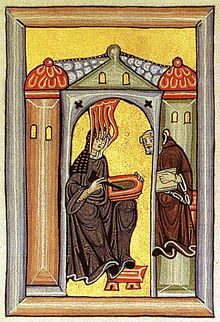 |
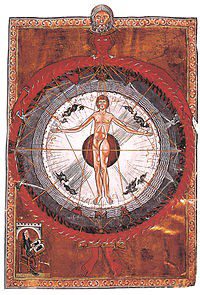 |
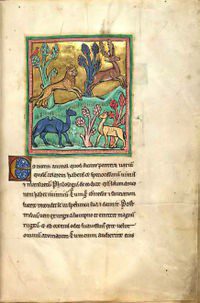 |
The macrocosmic element influenced man, the microcosm. If the humors of the body raged fiercely, the person was being influenced by the “wind” of the leopard, for example. The humors could also growl figuratively like an angry bear or rage forth suddenly, like a stag. She related morality with the internal organs. Thus, since the humors passed through the liver, wisdom is tested there and since they pass through the brain, the strength of the spirit is passed to the humors.
 |
As Hildegard elaborates the medical and scientific relationship between the human microcosm and the macrocosm of the universe, she often focuses on interrelated patterns of four:
- The four elements (fire, air, water, and earth);
- The four seasons, the four humors;
- The four zones of the earth; and
- The four major winds.”
Although she inherited the basic framework of humoral theory from ancient medicine, Hildegard’s conception of the hierarchical inter-balance of the four humors (blood, phlegm, black bile, and yellow bile) was unique, based on their correspondence to “superior” and “inferior” elements—blood and phlegm corresponding to the “celestial” elements of fire and air and the two biles corresponding to the “terrestrial” elements of water and earth. Hildegard understood the disease-causing imbalance of these humors to result from the improper dominance of the subordinate humors. This disharmony reflects that introduced by Adam and Eve in the Fall, which for Hildegard marked the indelible entrance of disease and humoral imbalance into humankind.
It happens that certain men suffer diverse illnesses. This comes from the phlegm, which is superabundant within them. For if man had remained in paradise, he would not have had the flegmata within his body, from which many evils proceed, but his flesh would have been whole and without dark humor [livor]. However, because he consented to evil and relinquished good, he was made into a likeness of the earth, which produces good and useful herbs, as well as bad and useless ones and which has in itself both good and evil moistures.
She found seven equal spaces “from the summit of the vessel of the brain to the extremity of the forehead”, which “are equal to seven planets”. Thus, Hildegard demonstrated the belief in symbolism of animals and numbers and the use of microcosm and macrocosm put to use to explain the nature of the universe.
A Summary of Symbolism in Medieval Art
The Humors
| Humors | Emotion | Animals | Elements |
| Blood | Cheerful | Ape/rabbit | Air |
| Phlegm | Sluggish | Ox/lamb | Water |
| Black Bile | Melancholic | Pig/elk | Earth |
| Yellow Bile | Irritable | Lion/car | Fire |
Horsemen of the Apocalypsewith Horse Colors and Symbols
| War | Red | Sword |
| Death | Pale | Sickle |
| Pestilence | White | Bow and Arrow |
| Famine | Black | Scales |
Sources
- Astin, A. E. (1978), Cato the Censor, Oxford: Clarendon Press
- Seneca, Lucius Annaeus. Natural Questions. trans. Harry M. Hine. Chicago IL., University of Chicago Press, 2010. ISBN 978-0-226-74838-2
- Inwood, Brad, Reading Seneca. Stoic Philosophy at Rome, Oxford: Oxford University Press, 2008.
- Cornford, Francis Macdonald (1997) Plato’s Cosmology: the Timaeus of Plato, Translated with a Running Commentary. Indianapolis: Hackett Publishing Company, Inc.
- Riddle, John M. (1985). Dioscorides on pharmacy and medicine. Austin: University of Texas Press. ISBN 0-292-71544-7.
- George, Wilma and Brunsdon Yapp. (1991) The Naming of the Beasts: Natural History in the Medieval Bestiary
- Schipperges, Heinrich. The World of Hildegard of Bingen: Her Life, Times, and Visions. Trans. John Cumming. Collegeville, MN: The Liturgical Press, 1999
- Caviness, Madeline. “Gender Symbolism and Text Image Relationships: Hildegard of Bingen’s Scivias.” In Translation Theory and Practice in the Middle Ages, ed. Jeanette Beer, pp. 71–111. Studies in Medieval Culture 38. Kalamazoo: Medieval Institute Publications, 1997.
PHILIP R. LIEBSON, MD, graduated from Columbia University and the State University of New York Downstate Medical Center. He received his cardiology training at Bellevue Hospital, New York and the New York Hospital Cornell Medical Center, where he also served as faculty for several years. A professor of medicine and preventive medicine, he has been on the faculty of Rush Medical College and Rush University Medical Center since 1972 and holds the McMullan-Eybel Chair of Excellence in Clinical Cardiology.

Leave a Reply